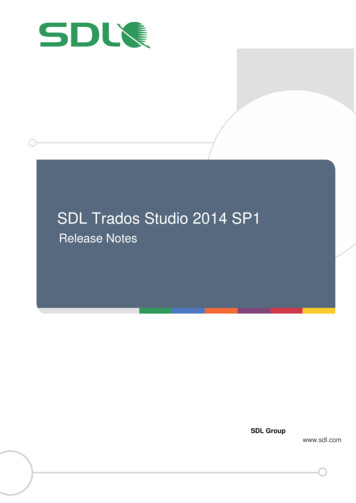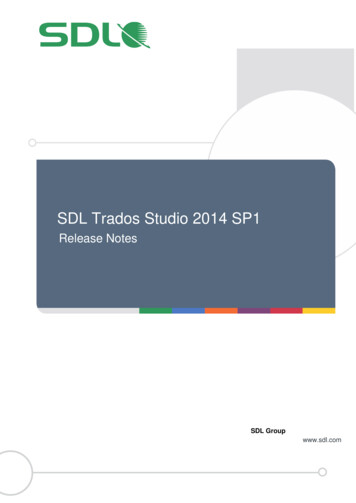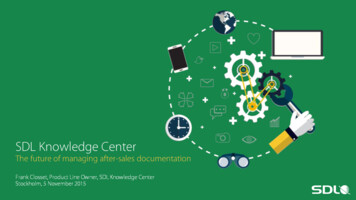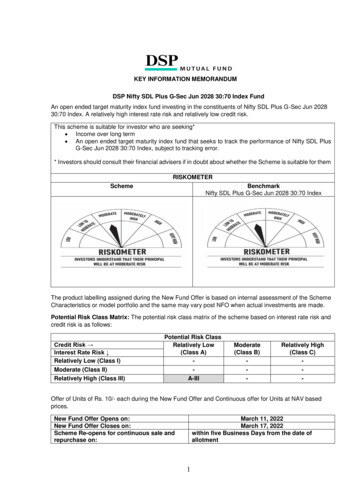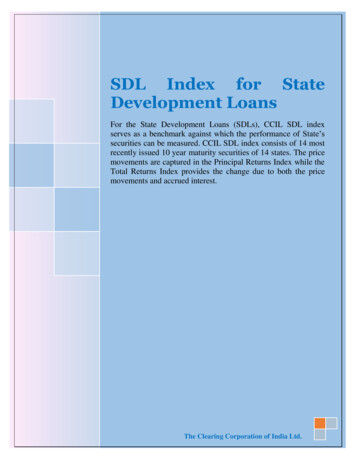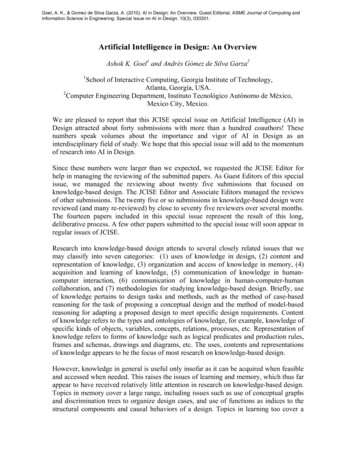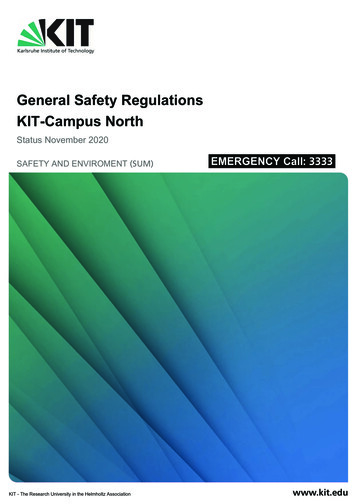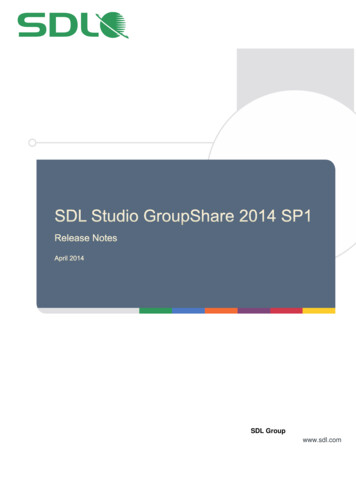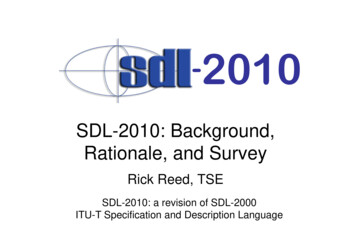
Transcription
-2010SDL-2010: Background,Rationale, and SurveyRick Reed, TSESDL-2010: a revision of SDL-2000ITU-T Specification and Description Language
Overview of session1. Presentation of SDL-2010 cf. SDL-2000Rationale for SDL-2010Differences between SDL-2010 and SDL-20002. Discussion on SDL-2010 & further changes
Rationale for 76 hite’Book2000ITU2011ITUSDL-84 SDL-88SDL-92SDL-2000SDL-2010 11 years since SDL-2000 SDL-2000 not fully implemented Impact of UML use Separation of concerns in standard documents
Reorganization Basic SDL-2010 - Z.101agent type diagrams containing agent instance structures with channels,state type diagrams and the associated semantics for these basic features. Comprehensive SDL-2010 - Z.102extends Basic SDL-2010 to full abstract grammar correspondingcanonical concrete notation: includes features such as continuoussignals, enabling conditions, type inheritance, and aggregate states. Shorthand notation & annotation in SDL-2010 - Z.103shorthands (agent diagrams, asterisk state) for easy and and moreconcise use; annotations (comments, create lines ), aidunderstanding but do not add to the semantics. Data and action language in SDL-2010 - Z.104data types and expressions. SDL-2000 data notation or C withbindings to the abstract grammar and the Predefined data package. SDL-2010 combined with ASN.1 modules - Z.105As for SDL-2000 except Predefined extensions moved to Z.104. Common Interchange Format for SDL-2010 - Z.106Similar to SDL-2000 (updated for feature changes).
Basic SDL-2010 Each diagram just one page!Lexical rules, frame use, page-numbersFramework, packages,referenced definitionsAgent types, state typesTypebased agents, proceduresChannels, interfaces, signalsState transition graphs:– start, state with input/save Transitions to:– nextstate, join, stop, return Actions:– tasks, create,proc. call, output, decision Timers, Data (overview)
PACKAGE Pkg1(1)USE PkgSYSTEMSystSYSTEMwom:Syst/*system specification *//* package diagram */Basic SDL-2010SYSTEM TYPE SystSIGNAL s;1(1)Cst1(1)s0ss0sctscSTATE TYPE Csts0ct cs:Cst/* system type diagram *//* state type diagram */
Comprehensive SDL-2010 Completes the abstract grammar–––––Priority input, Enabling condition, Continuous signalSpontaneous transitionsComposite state aggregationComposite state named entry/exit, entry/exit proceduresStatement list in tasks/procedures/operations, loops Completes (not “syntactic sugar”) features– Inheritance (specialization) Virtuality & Context parameters– Remote procedures/variables– Generic systems (select, optional transition)– Macros– Unicode handling
Shorthand SDL-2010and Annotation Instance diagramAgent with state graphAsterisk input/save, implicit transitionSignallist, interface as stimulus/on channelAsterisk state, multiple state appearanceMultiple diagram pagesVarious syntax alternativesCreate line (the only annotation left?)
System diagram (example)SYSTEM wom1(1)s0s0sSIGNAL s;s0/* system diagram */
Deleted: Specification areapack11pack1system syspackbbpackcp Attempt to standardize a collective view– “ a graphical depiction of the relationships between system specification and package diagram s.”
Deleted: Nested diagramssystem sblock b[s][t] [s]c[t]process prs0s0sts0
Deleted: Class symbolssti : Integer;b: Boolean;
Deleted: tension Some concrete syntax rules to ensure UML-like But no meaning (in SDL-2000) And consistent with deleting class symbols
Deleted: Name class and spellingvalue type Digit Character constants'0','1','2','3','4','5','6','7','8','9' endsyntype;value type Dstringinherits String Digit ( '' emptystring )addingoperators ocs in nameclass'''' ( ('0':'9')) '''' - this Dstring;/*strings of digits '0' to '9’, '00' to ’99’ */operator ocs - this Dstring{result )-2)};operator private mkDs(d Charstring)- this Dstring{result mkstring(d[1])//(if length(d) 1 then '’else mkDs(remove(d,1,1))};endvalue type Digitstring; Removed as user feature– still used to explain Predefined data types
Use with ASN.1 (Z.105)USE MyASN1/ INTER FACE MyMessages;SYSTEM useASN11(5)/*implies the SDL-2010 interface*/interface MyMessages{signalconnectd ( Destination ),sendInfo ( Information ),disconnect ( ConnectRef );}whereMyASN1DEFINITIONS AUTOMATIC TAGS :: BEGIN-- definitions includingMyMessages :: CHOICE {connectd Destination,sendInfo Information,disconnect ConnectRef}-- the data types mentioned-- above such as Destination-- and Information visible here.END
Z.104 (10/2004) - implicit choiceFor a path that has encoding, a data type is implicitlydefined that corresponds to the SDL:value type Implicitname /* an implicit and unique name*/{ choicesignal1 value{ struct1 Sort11 optional;2 Sort12 optional;3 Sort13 optional;/* . and so on foreach parameter of signal1 */} ;signal2 value{ struct1 Sort21 optional;2 Sort22 optional;3 Sort23 optional;/* . and so on for eachparameter of the signal2 */} ;signal3 NULL;/* no parameters *//* . and so onfor each signal */}
Signal as Structure as SignalA signal definition with parameters defines a structure data type that is anew basic sort alternative as signal as signal :: as signal signal identifier signal memo ( Cs, Receipt); /* definesvalue type anon{struct anon1 Cs optional;anon2 Receipt optional};*/dcl my memo as signal memo /* anon */, r Receipt;r : my memo.2; /* .anon2 *//* access by field number alternative to field name field number :: integer name */signal memo2 (c1 Cs, r2 Receipt); /* names fields forvalue type anon3 { struct c1 Cs optional; r2 Receipt optional};*/value type Memo struct { struct cs1 Cs; r3 Receipt};signal memo3 ( struct Memo struct); /* names fields forvalue type anon4 { struct cs1 Cs optional; r3 Receipt optional};*/dcl my memo2 as signal memo2, my memo3 as signal memo3;my memo2.c1 : my memo3.cs1 /* field names */
Choice as interface, gate or channelAn interface, gate or channel definition defines a choice data type that is a new basic sort alternative as interface , as gate or as channel : as interface :: as interface signal identifier as gate :: as gate gate identifier as channel :: as channel channel identifier interface pad{signal memo(Cs,Receipt),memo2(c1 Cs,r2 Receipt),memo3(struct Memo struct);}/* definesvalue type anon5 {choicememo as signal memo;memo2 as signal memo2;memo3 as signal memo3};*/dcl m as interface pad /* anon5 */;r : if memoPresent(m)then m.memo.2/*anon2*/elseif memo2Present(m)then m.memo2.r2else r fi fi;Similarly, for a gate or channel a choice data type for the signals carried.Because an interface use list includes signals defined elsewhere, the name ofsignal is not necessarily unique, so it is also allowed to denote the field name of thechoice by as signal , and to use Present(n) to test the presence if field n.r : if Present(2) then m.as signal memo2.r2 else r fi;
Choice as gate or channel[s1,s2][s3,s4]c1A gate or channel definition defines a choice data type for all the signalscarried by the channel in either direction.The channel above defines/* value type anon7 {choices1 as signals2 as signals3 as signals4 as signals1;s2;s3;s4};*/dcl c1 choice as channel c1 /* anon7 */;The choice types are useful in combination with input and output.* in choicec1 choicec1 choiceIssue not resolved: Variable is NOT transition local so still need to copysignal from input port to choice variable
Defining synonyms as variablesIn SDL-2010 the concept of a synonym isredefined as a read-only variable.This was not possible before SDL-2000because variables could not be definedanywhere.Nothing is changed in the concrete grammar,but a synonym in SDL-2010 then has aVariable-definition in the abstract grammar thatenables mapping of UML read-only attributes tosynonyms when using Z.109.
Lower bound on number of instances number of instances :: ( [ initial number ] [ , [ maximum number ] [, lower bound ] ] )This makes it possible to specify the number of instances is static.myprocess(2,2,2) /*always 2 */Or for the minimum number to be stated.myprocess(2,,1) /*never 1*/Attempting to stop an instance in a set at the lower bound raisesOutOfRange, so to avoid this occurring a new active expressionactive (myprocess)gives the number of active instances in an agent set.
Input viasg1PROCESS TYPE Viaducts02(7)s1s2ss via g1sg2s via g2sss via g3sg3s1s2s2s3Only one input or save can contain s via g1 for the same state.Only one input or save can contain s (without a gate).Assume signal s is the next signal in the input queue.In state s0, if s arrived via g1 the next state is s1. If s did not arrive via g1 next state is s2.In state s1, if s arrived via g2 the next state is s2.If s did not arrive via g2, the signal remains in the input queue(if this is the only transition from s1, until a signal s arrives via g2).In state s2, if s arrived via g3 the signal remains in the input queue.If s did not arrive via g3, the next state is s3.If there is no explicit input/save for s without a gate, there is an implicit input for s without a gate.In a process (rather than a process type), the name of a channel attached to a gate can be usedfor the via. In the implicit process type this is transformed to the gate connected to the channel.
Priority input value priority input list :: priority stimulus {, priority stimulus }* priority stimulus :: stimulus [ priority [ priority name ] ]The change is to allow multiple levels of priority specified bya priority name (a natural number literal).The higher the number the lower the priority, with zero thehighest priority (consistent with Continuous signal priority).An omitted priority name isone greater thanthe highest explicit priority name .
Priority input value exampleAssume signals X, Y, Z, N each with one parameter saved in x, y, z, n resp.Assume Tx, Ty, Tz and Tn connect to transitions that terminate in state st1.Assume st1 reached & input port contains in arrival order signals N, Y, Z, X.Z input for has an implied Priority-name of 3.The signal Y is enabled and consumed - has highest priority and Ty is taken.If no Y signals have arrived, at st1 again signal X is enabled and consumed.If no X or Y signals have arrived, at st1 again signal Z is enabled and consumed.If no X, Y or Z in the input port in state st1, Signal N is enabled and consumed.If the inputs for two or more signals have the same input priority, the signal thatarrived first is consumed.
Using signallist as an interface In SDL-2010Every signallist definition is a shorthand for aninterface definition.signallist sl : s, t, u, v;Defines an interface definition sl containingsignals s, t, u and v.The notation “(sl)” has the same meaning as“interface sl”When used on a channel or gate or in anothersignallist, the signallist name stands for the list ofsignals of the interface (as in SDL-2000).
Timer supervised statess0stsstate timernow 3tt state timer :: state timer Time expression set set clause For an optional State-timer, the timer is set entering the stateand reset entering a Transition, except for an emptyTransition to the state. Timer expiry: the timer signal isconsumed Transition of the State-timer taken.
Pending: Specified delayOutput-node::Signal-identifier Actual-parameters[Signal-destination] Direct-viaActivation-delay Signal-priority output body item :: signal identifier [ actual parameters ][ activation delay [ signal priority ]] activation delay :: active Duration expression signal priority :: priority Natural expression If activation delay is omitted, the Activation-delay is zero: that is, there is no delay inactivating the signal at the destination.If signal priority is omitted, the Signal-priority is zero: that is, the signal has the highestsignal priority.Conveyed “availability time” now Activation-delay - sent only if Activation-delay veAgentIf a signal conveys an availability time, the signal is not delivered to the input port until thistime has been reached.The set of retained signals is ordered in the input port according to their availability time,which for signals that do not convey an availability time is the same as their arrival time.
Issues: pids and instance setsIssue: How to handle the pid values of agent instances.Option: if an agent instance set is named ais, treat the expressionais[k]as indexing a string of pid values for the ais instances.But if k is an integer index, may be too simplistic as the number ofinstances is potentially variable, so ais[2] may not be constant.Could have k as a “key value”, but then need some way of defining keys.Issue: Initializing static agent instance sets.Not currently allowed to give any agent parameters in the set definition.In any case, each instance probably needs different parameters.Before system execution so dynamic evaluation is not possible.There may be a relationship between keys (see above) and parameters.
Deleted: object data types Complex––––Not implemented (as in standard)Implicit conversions value/objectDynamic data typesNot supported by ASN.1 or encoding rules Strategy– Remove from initial SDL-2010, but further studyon extending Z.104 is in progress.
ITU maintenance guidelines (extract)Study group experts should determine the levelof support and opposition for each change andevaluate reactions from users. A change willonly be put on the accepted list of changes ifthere is substantial user support and no seriousobjections to the proposal from more than just afew users. Finally, all accepted changes will beincorporated into a revised ITU-T Rec. Z.100.Users should be aware that until changes havebeen incorporated and approved by the StudyGroup responsible for ITU-T Rec. Z.100 theyare not recommended by ITU-T.
StatusZ.100 (Introduction) needs finishingZ.101 to Z.105 ‘almost complete’ need review.Z.106 needs to be revisedZ.1xx Object data - in progress - Feb 2012Z.109 Work in progress for Feb 201
data types and expressions. SDL-2000 data notation or C with bindings to the abstract grammar and the Predefined data package. SDL-2010 combined with ASN.1 modules - Z.105 As for SDL-2000 except Predefined extensions moved to Z.104. Common Interchange Format for SDL-2010 - Z.106 Similar to SDL-2000 (updated for feature changes).

